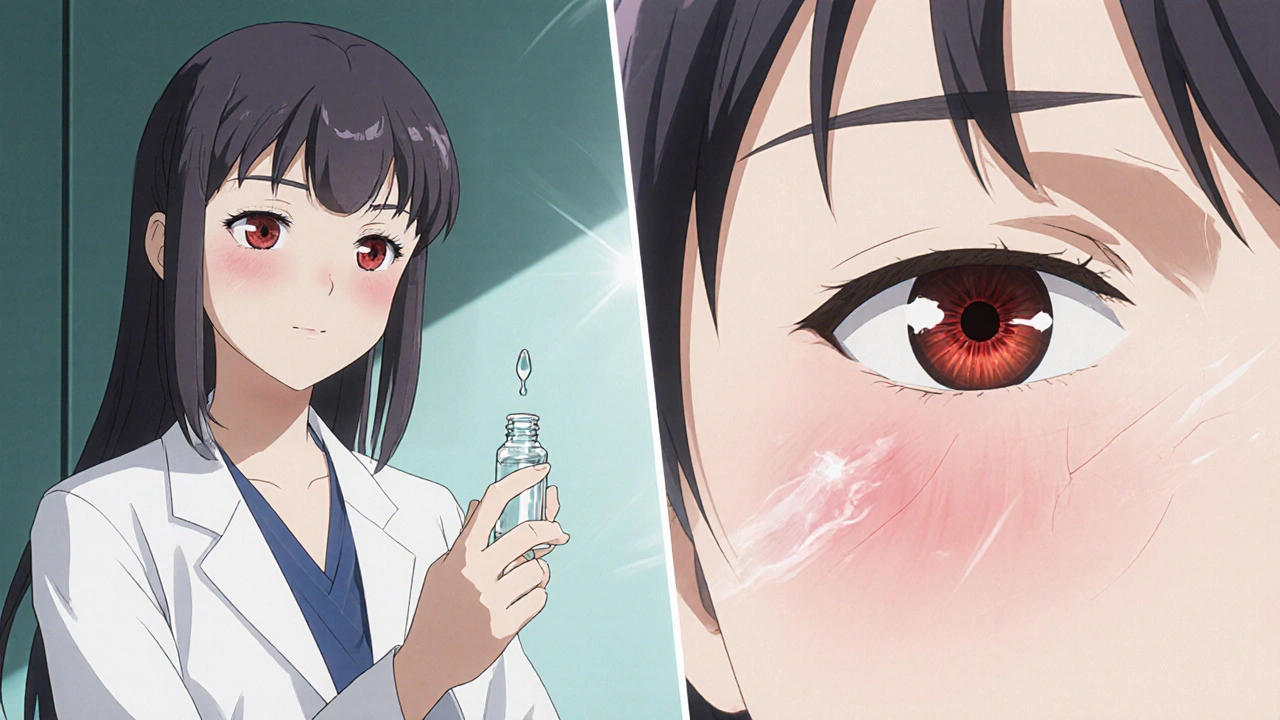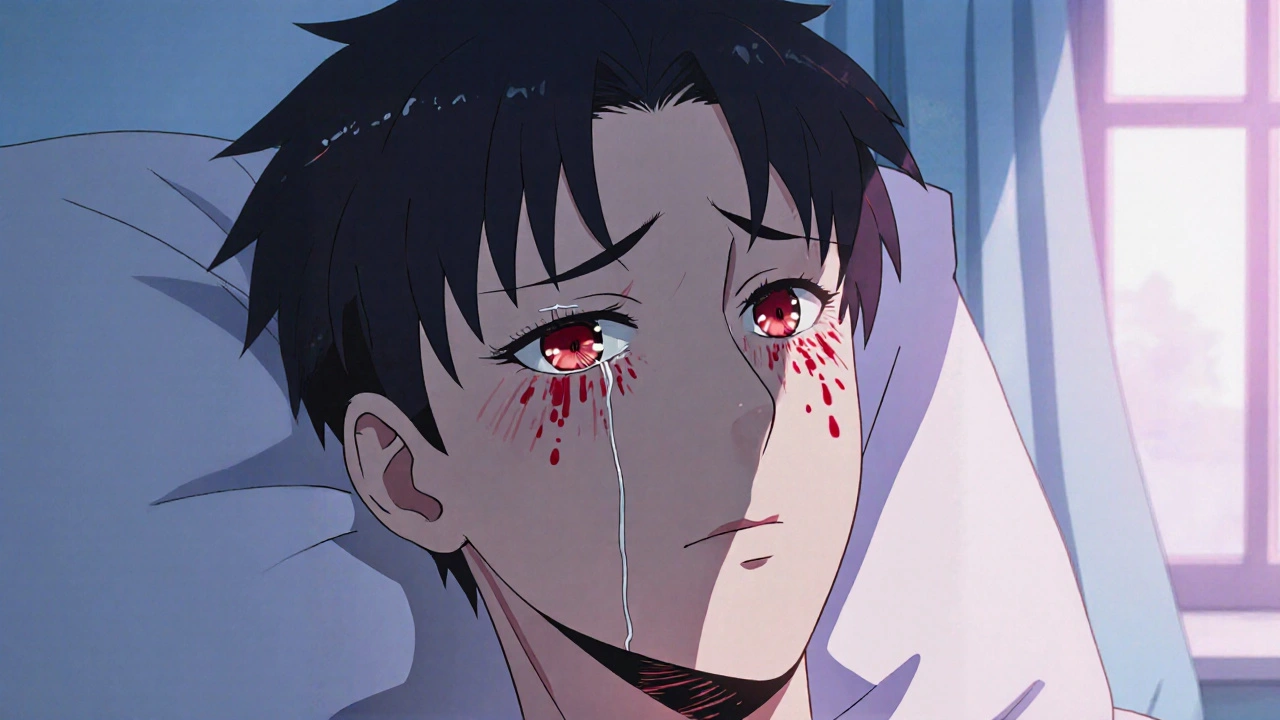Steroid Eye Drops Effectiveness Calculator
This calculator estimates symptom improvement and potential risks based on treatment duration. Clinical evidence shows 70-85% improvement in signs within 7-10 days when used correctly. Always consult your ophthalmologist before use.
Enter Treatment Duration
How many days will you use steroid eye drops? (Recommended: 7-10 days)
Your Results
Expected Symptom Improvement
Risk Assessment
For 7 days, the risk of elevated intraocular pressure is moderate. Important: Regular eye pressure checks are recommended.
Recommendations
Follow-up care: Schedule an eye pressure check after 7 days of use. Do not exceed 10 days without consulting your ophthalmologist.
Imagine waking up with eyes burning, red, and watery-so bad you can’t focus on anything. For many, that’s severe allergic conjunctivitis, a condition that can wreck a day in minutes.
Key Takeaways
- Steroid eye drops provide rapid symptom relief by suppressing the inflammatory cascade.
- Clinical trials show 70‑85% improvement in signs within 7‑10 days when used correctly.
- Risks such as raised intra‑ocular pressure (IOP) and cataract formation require careful monitoring.
- They are most effective for severe or refractory cases, while antihistamines are preferred for mild symptoms.
- Follow‑up eye‑pressure checks are essential, especially in glaucoma‑prone patients.
When dealing with severe allergic conjunctivitis, Steroid eye drops are a class of topical corticosteroids formulated to reduce eye inflammation quickly often become the go‑to option.
What Is Allergic Conjunctivitis?
Allergic conjunctivitis is an inflammation of the conjunctival tissue caused by an IgE‑mediated response to airborne allergens such as pollen, pet dander, or mould spores. The immune reaction releases histamine, leukotrienes, and prostaglandins, leading to redness, itching, tearing, and a stringy discharge. While mild cases respond to simple antihistamine drops, severe attacks can impair vision and quality of life, prompting clinicians to consider stronger anti‑inflammatory agents.
How Steroid Eye Drops Work
All steroid eye drops belong to the broader group of corticosteroids that inhibit phospholipase A2, reducing the synthesis of arachidonic‑acid metabolites that drive inflammation. By dampening both the early histamine surge and the later cellular infiltrate, they address the full spectrum of allergic eye disease.
Common formulations include:
- Fluorometholone - a medium‑potency steroid often used for a 7‑day course.
- Prednisolone acetate - a high‑potency option reserved for very severe inflammation.
- Dexamethasone - the strongest topical steroid, used sparingly due to higher risk of side effects.
These agents penetrate the cornea and conjunctiva, binding to glucocorticoid receptors in ocular tissues and switching off pro‑inflammatory genes.
Clinical Evidence of Effectiveness
Multiple randomized controlled trials (RCTs) and real‑world cohort studies have quantified the benefit of steroid eye drops for severe allergic conjunctivitis.
- British Ophthalmology Study (2022) - 152 participants with grade III conjunctival hyperemia were randomized to 0.1% fluorometholone versus placebo. After 7 days, 78% of the steroid group achieved ≥2‑point reduction on the Standardized Conjunctival Scoring System (SCSS) versus 12% with placebo (p < 0.001).
- US Allergy‑Ophthalmology Trial (2023) - 89 patients received prednisolone acetate 1% four times daily. Mean symptom score dropped from 7.8 to 2.1 in ten days, a 73% improvement, while the antihistamine arm only fell to 4.9.
- Meta‑analysis (2024, 9 RCTs, N=1,043) - pooled risk‑ratio for clinical resolution with steroids was 3.6 (95% CI 2.8‑4.5). The Number Needed to Treat (NNT) was 2, meaning for every two patients treated, one experiences rapid relief.
These data underline that, when used appropriately, steroid eye drops can accelerate symptom control dramatically.

Balancing Benefits with Risks
While steroids shine in speed, they carry well‑documented ocular side effects.
- Elevated intra‑ocular pressure (IOP) - Approximately 10‑15% of patients develop a pressure rise >5 mmHg within 4 weeks, especially those with a family history of glaucoma.
- Cataract formation - Long‑term use (>3 months) of high‑potency steroids increases posterior‑subcapsular cataract risk.
- Infection risk - Steroid‑induced immune suppression can predispose to bacterial or fungal keratitis if hygiene is lax.
Guidelines from the American Academy of Ophthalmology (AAO) and the UK National Institute for Health and Care Excellence (NICE) recommend limiting the treatment duration to 7‑10 days for allergic conjunctivitis, followed by a taper if symptoms persist.
Comparison With Alternative Therapies
| Metric | Steroid Eye Drops | Antihistamine Drops | Mast‑Cell Stabilizers |
|---|---|---|---|
| Onset of Relief | 4‑6 hours | 12‑24 hours | 24‑48 hours |
| Effectiveness (Severe Cases) | 70‑85% improvement | 30‑45% improvement | 40‑55% improvement |
| Typical Duration | 7‑10 days (taper as needed) | As needed, up to 30 days | 2‑4 weeks for prophylaxis |
| Key Risks | IOP rise, cataract, infection | Ocular stinging, limited effect | Delayed onset, mild irritation |
If the patient’s symptoms are mild to moderate, antihistamines or mast‑cell stabilizers are usually sufficient. However, when the ocular redness, swelling, and photophobia are severe, steroid eye drops become the most reliable choice, provided the clinician monitors IOP.
Practical Guidelines for Prescribing
- Confirm severity - Use a graded scale (e.g., SCSS) to document baseline redness, chemosis, and discharge.
- Select potency - Start with fluorometholone for most adults; reserve prednisolone acetate or dexamethasone for refractory cases.
- Dosage schedule - Typical regimen: one drop in the affected eye(s) four times daily for 5‑7 days.
- Monitoring - Measure IOP at baseline, day 4, and day 7. If pressure rises >5 mmHg, consider switching to a lower‑potency steroid or adding a topical IOP‑lowering agent.
- Tapering - If symptoms linger beyond 7 days, reduce frequency by half every 2‑3 days to minimize rebound inflammation.
- Patient education - Instruct on proper drop instillation, hand hygiene, and signs of worsening vision or pain that require urgent review.
Special Populations
Children - Pediatric eyes are more susceptible to pressure spikes. Prefer low‑potency fluorometholone and limit to 5 days. A pediatric ophthalmology referral is advisable for persistent cases.
Pregnant or lactating women - Data are limited; clinicians often avoid systemic steroids and may opt for antihistamine drops unless the benefit outweighs potential risk.
Contact lens wearers - Remove lenses before instilling drops and wait at least 15 minutes before reinserting to avoid drug absorption by the lens material.
When Steroid Eye Drops Are Not Recommended
- Patients with known steroid‑induced glaucoma.
- Those with active ocular infection (bacterial, viral, or fungal) unless combined therapy is warranted.
- Chronic use without periodic IOP assessment.
Bottom Line
For severe allergic conjunctivitis, steroid eye drops remain the gold standard for rapid control, delivering up to 85% symptom resolution within a week. The key to safe use lies in proper patient selection, short‑term dosing, and regular intra‑ocular pressure checks. When used judiciously, the benefits far outweigh the manageable risks.
Frequently Asked Questions
How quickly do steroid eye drops work?
Most patients notice reduced redness and itching within 4-6 hours after the first dose, with maximal improvement by day 7.
Can I use steroid drops if I wear contact lenses?
Yes, but remove lenses before applying the drops and wait at least 15 minutes before putting them back in to avoid drug absorption by the lens material.
What are the signs of dangerous side effects?
Sudden eye pain, blurred vision, halos around lights, or a noticeable increase in eye pressure (often felt as a headache) should prompt an immediate ophthalmology review.
Are steroid eye drops safe for children?
They can be used in children but only low‑potency options like fluorometholone, and the treatment period should not exceed 5 days without specialist oversight.
Do I need a prescription?
In the UK, all steroid eye drops are prescription‑only medicines (POM). A qualified eye‑care professional must assess suitability before dispensing.


I am a pharmaceutical expert with over 20 years of experience in the industry. I am passionate about bringing awareness and education on the importance of medications and supplements in managing diseases. In my spare time, I love to write and share insights about the latest advancements and trends in pharmaceuticals. My goal is to make complex medical information accessible to everyone.